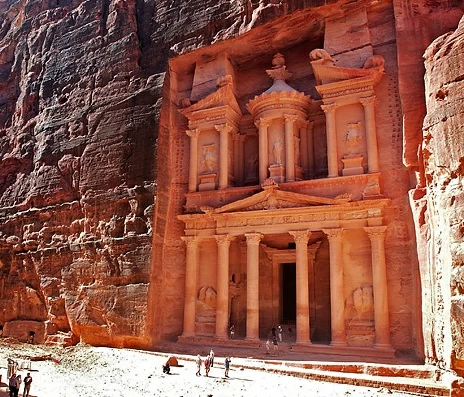Information on Petra
Before planning a holiday to Petra, come and learn a few important facts about this outstanding site. Petra lies some 230 Km south of Amman. The opportunity for a Jordan Petra tour is a dream come true to many travellers, as it is Jordan’s best known archaeological site, Petra tours being the jewel in the crown of the tourism industry in Jordan. Petra was voted as a new 7th wonder of the world in 2007 and is a UNESCO World Heritage Site.
Petra, meaning “rock” in Greek, was the capital of the Nabataean Kingdom. Tours to Petra had not been possible as the site was unknown to the west until a Swiss scholar discovered it in 1812. Johann Burkhardt was the first westerner to ever tour Petra and to write about his incredible discovery at the time. Accessible through a narrow gorge (siq) over 50 meters high in some places, visitors coming to spend their holiday in Petra are met by a magnificent 30-metre high monument carved in the pink rock at the end of the siq. Known as The Treasury or Al Khazneh in Arabic, it is Petra ‘s most elaborate monument. Petra enjoyed the peak of its prosperity during the 1st century BC when it was thought to have had 30 thousand inhabitants. During antiquity, merchants travelled to Petra on caravans on their way towards Gaza and Syria on the spice route.
Petra Tours in modern times
Although today hundreds of thousands of people travel each year on holiday to Petra, until the 1980s travelling to, and touring Petra was difficult, as there was but a single small hotel in the region of Petra. It was called the Nazzal hotel and was visited by Agatha Christie in 1933, where she penned her novel ‘Appointment With Death’. Today tours to Petra are easily arranged, as there is a good tourism infrastructure in Wadi Musa (Wadi Musa is the name of inhabited town outside the archaeological site), which is a bustling town with some 25 thousand inhabitants, virtually all employed in tourism.
Tourist hotels in Petra
Nowadays, if you are seeking tours to Petra, accommodation can be easily arranged as Wadi Musa contains quite a few hotels offering wide ranging standards. The best hotels are the ones located by the gate of the archaeological site; The Petra Mövenpick, 5* The Petra Guest House, 4* and the Petra Palace 3*. Other good quality hotels are mostly located on the mountain overlooking Petra (The Petra Marriott 5* and the Nabatean Castle 5*) while two renovated 19th century farming villages have been converted into charming luxury hotels; The Old Village Resort in Wadi Musa and Hayat Zaman in Taybeh, which is located some 12 km south of Wadi Musa.
There are also a few camps located around Petra, in the Beida area; such as the Petra Bubbles Luxotel, which is upmarket and the Ammareen Camp, which is more basic and owned by the local Bedouin cooperative. Nowadays, tours to Petra booked through Jordan Select Tours are completely tension-free, as we have excellent relationships with hotels in that region, and we have our own specialised guides in Petra.
Restaurants and nightlife in Petra
Unfortunately, there are not many good quality restaurants outside of the main 5* hotels in Petra, and the nightlife is non-existent. Most visitors undertaking a tour of Petra during the day take it easy after a relatively tiresome day in the ruins, and spend their post-tour time around their hotel pool, reading a book, or relaxing over a well-earned drink.
Petra Incentives
We are experts in setting up and organising incentives in Petra that draw on the magnificent heritage of the site and its unique history and architecture. Several themes can be considered. Locations range from the monument of little Petra (Beida) to an area not far from the archaeological park itself.






